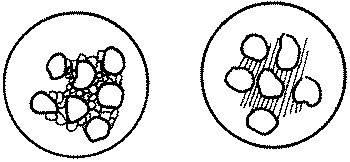BACKGROUND:
The name "cement" generally refers to a
chemical "binder" or adhesive. Adhesives bond materials as they
dry out of an organic solvent or by a polymeric chemical reaction. The
chemical and physical processes of adhesion, and therefore of cement, are
not completely understood.
In contrast, in geology cementation refers to the
hardening and welding together of sedimentary fragments such as sand by the
precipitation of minerals in the spaces between the fragments. The particles
are not glued together, but held in place by the precipitated minerals. The
most common mineral is quartz, but calcite, other carbonates, iron
oxides, and clay minerals also form cement.
The concrete used in the building industry forms the same
way as geological cements. Concrete is made of rocks, sand, and cement. It
is one of the most inexpensive, widely used, and durable building materials
available. Man-made geological cements have been used for a long time.
Cement dates back more than 5,000 years to the construction of the Great
Pyramids in Egypt. The cement used by the Egyptians was a "calcined"
gypsum (dried to remove water), which today is commonly known as plaster of
Paris. The Mycenaeans and Phoenicians realized that the calcined gypsum
cement was not very strong, and found that a lime-based ("lime" =
CaO) cement was much stronger and durable. This lime-based cement is very
similar to the cement in modern concrete. The most impressive use of
concrete in the ancient world was by the Romans, who improved the strength
of the cement and used it to construct most of their famous monuments and
buildings.
In 1824, Joseph Aspdin developed a process for measuring
out limestone and clay, converting them to powder, heating the powder, and
then grinding them into another powder finer than flour. He found that if he
mixed this cement with water and aggregate, i.e., a mixture of sand and
rock, the resulting material had nearly twice the strength of many natural
mineral cements. This cement was named "Portland cement" because
the limestone was mined on the English island of Portland.
Modern concrete is mixed in proportions that are
expressed in three numbers. For example, 1:2:3 means one part Portland
cement, two parts of clean sand, and three parts gravel or pebbles (often
called aggregate).
 A common misconception about concrete is that it hardens
or dries through evaporation. Actually, concrete hardens because of chemical
reactions that take place when water is added to the dry concrete mixture.
These produce new chemical compounds that lock in water between their
molecules. This process, known as hydration, forms crystals that bind the
concrete mixture together. These new crystals fill in the spaces between the
aggregate, cement, and sand. The speed of hydration depends on the
temperature, amount of water, and the fineness of the cement.
A common misconception about concrete is that it hardens
or dries through evaporation. Actually, concrete hardens because of chemical
reactions that take place when water is added to the dry concrete mixture.
These produce new chemical compounds that lock in water between their
molecules. This process, known as hydration, forms crystals that bind the
concrete mixture together. These new crystals fill in the spaces between the
aggregate, cement, and sand. The speed of hydration depends on the
temperature, amount of water, and the fineness of the cement.
The process of hydration takes curing time. The concrete
mixture can lose up to half of its strength if it is not kept wet during the
first 7 days after pouring. The full hydration time for common cement is
about 28 days. The longer the curing time, the more hydration takes, place
and the stronger the concrete becomes. Concrete thus becomes stronger as it
grows older. In this lab, the students learn the difference between
cementation and adhesion. This will emphasize that cementation is the
process used in creating sedimentary rocks.
PROCEDURE:
- Before lab, prepare laboratory materials for each student group.
- Have the students make adhesive and cement mixtures, following the
worksheet instructions. The students will see that the plaster of Paris
and concrete form solids by hydration. The flour and water paste is an
adhesive formed by evaporation of the water.
- Tell the students to measure the mixtures accurately or the end
product may not solidify properly. If the students add too much or too
little water, make sure that they record their observations. You can then
discuss the "failures" and "successes" and their causes.
- The concrete mix might take a day to completely dry. Have students
observe it over time. Looking at the mixture with a microscope will help.